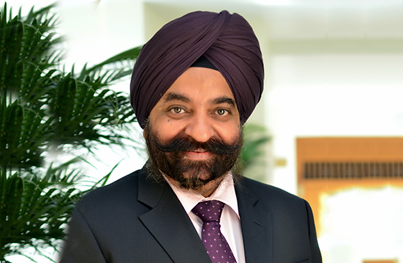The core of all we do is investor centricity
BFSI Industry Interview

Mr. D. P. Singh has over 30 years of experience in the Banking and Financial Services Industry and has been associated with SBIMF since 1998. As DMD & Chief Business Officer, he is responsible for all business verticals and segments of the organisation. Over the years, he has overseen many roles across various functions in the organisation. Before joining the company, he was with SBI, handling various assignments in Retail Banking, Corporate Credit and Information Technology Initiatives.
In an interview with AdvisorKhoj, DP Singh shares his thoughts on various topics across the industry and the SBIMF.
How do you see the growth of the MF industry going forward? What are the key trends that are emerging in your view?
In the last 10 years, the AUM of the Indian MF industry has grown over 5 times to reach over Rs 44 lakh crore. At the same time, only about 8% of the total PAN account holders currently invest in mutual funds. Imagine the scale, if we increase this number and reach out to a much larger section of the population over the next few years.
Systematic Investment Plans have been a major driver for the growth of the industry over the years. This trend will only continue going forward. With facilities like top-up SIPs, not just new investors but even existing investors can increase their SIPs.
It is a win-win for investors as well as the MF industry. The power of mutual funds lies in the comprehensive solutions it provides for meeting financial goals and this is getting more acceptance. As an industry, we are moving from product selling to solutions selling, which is very good.
What would you like to tell investors who are pausing their SIPs?
Last month, as an industry, we saw the highest number of registrations for new SIPs. The inflows in mutual funds through SIPs are also at a record level. There could be some investors who might pause SIPs for various reasons, but it is clearly not a major trend. The Pause SIP facility is an added convenience to investors who want to manage their immediate cash flows at times. However, unless there is a real need, SIPs must not be stopped to continue benefiting from the power of compounding.
With the regulations on commissions, starting an MFD practice/business has become very difficult. It is not an issue after reaching a certain size, but the starting point and first few years are challenging. So, what would you say to the new MFDs starting their business now?
Like any other entrepreneur, the initial grind is needed even in the mutual fund distribution business. With evolving needs and changing dynamics of the industry, all stakeholders have to adopt certain changes. For instance, introducing the regulatory sandbox aims to bring in new distributors to expand the distribution network and support them during the initial stages. In my experience, the Indian MF industry, including the distribution network, has also adapted to numerous changes in the past. This is part of the business. New MFDs should note that the potential for growth in mutual funds in India is huge, and where there is potential, there is growth.
How do you see the distribution space evolving with the MFDs and RIAs?
With the expected growth of new investors in the country, there is sufficient space to growth for both MFDs and RIAs. The clientele of these two intermediaries is very different, and ample opportunities lie.
What is your AMC’s plan going forward? Between AIF/PMS space and the passive funds, where do you think we will see more innovation and higher participation by investors?
In the foreseeable future, higher participation will likely continue in the mutual fund space. As an AMC, we have different pillars which cater to different audience segments. For niche investors, we have offerings in the alternatives space where we seek innovative alpha generation opportunities. There are enough alpha generation opportunities available in a growing market like India. So, while passive investing will grow, the interest in active investing will be higher. There are enough asset management solutions for all types of investors.
From an investor’s perspective, how are mutual funds placed vis-à-vis the NPS? How should an investor split their investments between the two?
Mutual funds give risk-adjusted returns along with liquidity, whereas, in NPS, liquidity is restricted. Investors can use NPS to plan their retirement allocations, while with mutual funds, they can plan for many more goals like capital building for children, short-term emergency funds, etc. In fact, with Retirement - oriented mutual funds, one can plan for retirement too.
B-30 AUM is about one-third of T-30 retail / HNI AUM. What are your views on B-30 growth potential? What are SBI MF’s plans for growing the B-30 business?
B-30 AUM would only grow as the financialisation of savings increases across the country.
At SBIMF, we are expanding our branch network to cover more and more B-30 locations. We are moving into smaller cities as we realise that these cities have people who are asset-rich and cash poor. The second generation of the family wants to move out of physical assets and allocate more money to financial assets. Therefore, the scenario of MF penetration in B 30 cities looks very good & SBIMF, with its strong brand recall and consistent long-term performance, is in the right space to utilise this opportunity.
What are SBI MF's plans both on the product side as well as on the distribution side?
Ideation on products, distribution or marketing is always ongoing at SBI MF. The core of all we do is investor centricity. We have a product pipeline based on the evolving needs of investors and various market opportunities that keep coming up from time to time. We also focus on providing seamless services to our investors through our online and offline channels. We continue to engage effectively with our distribution network. For instance, we have created forums to discuss ideas for innovation and growth of the industry with our key channel partners, taking their feedback and plan regular training programs for them.
Mutual Fund Investments are subject to market risk, read all scheme related documents carefully
Recent Interviews
-
In conversation with Mr Vaibhav Shah Head Products: Business Strategy & International Business Mirae Asset Mutual Fund India
Apr 18, 2025
-
In conversation with Mr Kaustubh Sule Senior Fund Manager Fixed Income with Groww Mutual Fund
Apr 18, 2025
-
In conversation with Mr Abhishek Tiwari Chief Business Officer of PGIM India Mutual Fund
Apr 5, 2025
-
In Conversation with Mr Akhil Chaturvedi Executive Director & Chief Business Officer with Motilal Oswal Mutual Fund
Mar 26, 2025
-
In conversation with Mr Rohit Seksaria Fund Manager Equity with Sundaram Mutual Fund
Mar 7, 2025
Fund News
-
Axis Mutual Fund joins ONDC Network to Expand Access to Mutual Fund Investments
Apr 18, 2025 by Axis Mutual Fund
-
Nippon India Mutual Fund launches Nippon India Nifty 500 Quality 50 Index Fund
Apr 18, 2025 by Advisorkhoj Team
-
Nippon India Mutual Fund launches Nippon India Nifty 500 Low Volatility 50 Index Fund
Apr 18, 2025 by Advisorkhoj Team
-
RBI Monetary Policy: RBI changes policy stance and lowers rate
Apr 9, 2025 by Axis Mutual Fund
-
Kotak Mahindra Mutual Fund launches Kotak Nifty Top 10 Equal Weight Index Fund
Apr 7, 2025 by Advisorkhoj Team




